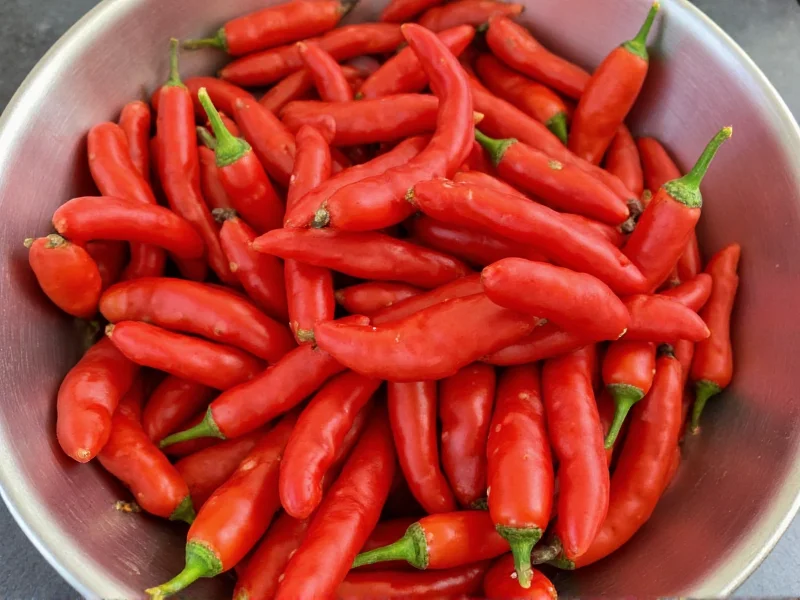When you can't find cascabel chiles—the small, round Mexican peppers known for their nutty flavor and medium heat (1,000-2,500 SHU)—you need reliable alternatives that maintain your dish's integrity. These versatile chiles appear in traditional mole sauces, salsas, and braises, so choosing the right substitute matters for authentic flavor. Understanding each option's heat level, flavor notes, and best applications ensures your Mexican recipes succeed even without this specialty ingredient.
Understanding Cascabel Chiles Before Substituting
Cascabel chiles (chile cascabel) deliver a distinctive combination of earthy, nutty, and slightly smoky flavor with moderate heat. Their round shape ("cascabel" means "rattle" in Spanish) makes them easy to identify, but their limited availability outside Mexico and specialty markets often requires substitution. When replacing cascabels, prioritize matching both heat level and flavor complexity rather than just spiciness.
Top 5 Cascabel Chile Substitutes Ranked
Not all substitutes work equally well across recipes. Consider these factors when choosing your alternative:
| Substitute | Heat Level (SHU) | Flavor Profile | Best For | Substitution Ratio |
|---|---|---|---|---|
| Guajillo | 2,500-5,000 | Tangy, berry-like, less nutty | Salsas, adobos, marinades | 1:1 (reduce by 25% for heat) |
| Ancho | 1,000-2,000 | Sweet, raisin-like, mild smoke | Moles, stews, soups | 1:1 (add pinch smoked paprika) |
| Pasilla | 1,000-2,500 | Berry, tobacco, earthy | Complex moles, braises | 1:1 (best single substitute) |
| Guajillo + Ancho Blend | 1,500-3,500 | Balanced sweet-tangy-nutty | Most cascabel applications | 1 part guajillo : 1 part ancho |
| Chipotle in Adobo | 2,500-8,000 | Intense smoke, vinegar tang | Smoky dishes needing depth | 1 chipotle = 3-4 cascabels (adjust liquid) |
Detailed Substitute Analysis
Guajillo Chiles: Closest Flavor Match
Guajillo chiles provide the most similar flavor profile to cascabels with their bright, tangy notes. While slightly hotter (2,500-5,000 SHU vs cascabel's 1,000-2,500), they work exceptionally well in salsa roja and adobo sauces. For the best cascabel chile alternative in mole recipes, use guajillos but reduce the quantity by 25% to match heat levels. Rehydrate both varieties in hot water for 15-20 minutes before blending.
Ancho Chiles: Milder, Sweeter Option
When seeking a mild substitute for cascabel chiles in family-friendly dishes, ancho chiles deliver with their sweet, raisin-like flavor and lower heat (1,000-2,000 SHU). They lack cascabel's distinctive nuttiness but excel in chicken moles and vegetable stews. Boost complexity by adding 1/8 teaspoon smoked paprika per ancho used. This combination creates an excellent cascabel chile alternative for Mexican recipes requiring depth without intense heat.
Pasilla Chiles: Complex Flavor Alternative
Pasilla chiles (chile negro) offer the closest single-chile substitute when matching cascabel's complexity. Their earthy, berry-like notes with subtle tobacco undertones work beautifully in traditional Oaxacan moles. Use a 1:1 ratio when replacing cascabels in braised dishes. Note that pasillas darken significantly when cooked—this visual difference doesn't affect flavor but may alter your dish's appearance.
Guajillo-Ancho Blend: Ultimate Flavor Replication
For the most authentic cascabel chile substitute in complex sauces, combine equal parts rehydrated guajillo and ancho chiles. This blend balances guajillo's tanginess with ancho's sweetness to mimic cascabel's unique profile. Use this mixture when preparing mole poblano or pipián sauces where flavor nuance matters most. The substitution ratio remains 1:1 by weight for dried chiles.
Chipotle in Adobo: Smoky Alternative
When your recipe specifically needs smokiness (like barbacoa or posole), chipotle peppers in adobo sauce provide intense smoke but require careful adjustment. One chipotle equals approximately 3-4 cascabel chiles in heat and flavor impact. Reduce other liquids in your recipe by 1-2 tablespoons per chipotle used, as the adobo sauce adds significant moisture. This works best as a cascabel chile alternative for specific smoky applications rather than general substitution.
Practical Substitution Tips
Follow these professional techniques when replacing cascabel chiles:
- Rehydration matters: Always rehydrate dried chiles in hot (not boiling) water with 1 teaspoon vinegar for 15-20 minutes to maximize flavor extraction
- Toast for depth: Lightly toast dried chile substitutes in a dry skillet for 30-60 seconds before rehydrating to enhance nutty notes
- Adjust liquid ratios: When using chipotle in adobo as a cascabel chile substitute, reduce other liquids by 15-20% to compensate for the sauce's moisture
- Balance acidity: Cascabels have natural tartness—add 1/2 teaspoon lime juice per cup of sauce when using ancho substitutes
- Heat control: Remove seeds and membranes from guajillo substitutes to better match cascabel's moderate heat level
Finding Substitutes Locally
While specialty Mexican markets carry all these options, standard supermarkets typically stock ancho and chipotle peppers. Look for them in the international foods aisle or near canned tomatoes. For the best cascabel chile alternative in mainstream stores, choose ancho chiles—they're widely available year-round. Online retailers offer guajillo and pasilla chiles in bulk, but check harvest dates; fresher chiles (within 1 year) provide significantly better flavor.
When Substitution Changes Authenticity
Recognize that some traditional dishes require specific chiles for authenticity. In mole de olla or salsa de cascabel, the unique nuttiness of cascabels defines the dish. For these recipes, the guajillo-ancho blend provides the closest approximation. However, in simpler applications like bean stews or chicken adobos, single-chile substitutes work perfectly. Understanding where flavor precision matters helps you decide when to seek specialty ingredients versus using accessible alternatives.











 浙公网安备
33010002000092号
浙公网安备
33010002000092号 浙B2-20120091-4
浙B2-20120091-4